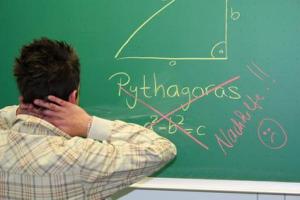摘要:根据一项新研究,学习数学的学生很有可能出现认知神经紊乱,影响基本数值和公式的处理。数值公式处理障碍的学生接受专门的教学,而这种教学模式应该广泛出现在主流教育机构中。
公式处理障碍和朗读障碍的患者一样所占比例高达7 %,通常认为患者是由于认知过程障碍所致,而科学家和教育家合作开发关键神经中枢模型,研究结果表明公式处理障碍患者的大脑结构有些异常。

数学公式认知紊乱的表现
Students who struggle to learn mathematics may have a neurocognitive disorder that inhibits the acquisition of basic numerical and arithmetic concepts, according to a new paper. Specialised teaching for individuals with dyscalculia, the mathematical equivalent of dyslexia, should be made widely available in mainstream education, according to a review of current research published in the journal Science.
Although just as common as dyslexia, with an estimated prevalence of up to 7% of the population, dyscalculia has been neglected as a disorder of cognitive development. However, a world-wide effort by scientists and educators has established the essential neural network that supports arithmetic, and revealed abnormalities in this network in the brains of dyscalulic learners.
Neuroscience research shows what kind of help is most needed -- strengthening simple number concepts. This can be achieved with appropriate specially-designed teaching schemes, which can be supported by game-like software that adapts to the learner's current level of competence.
Professor Brian Butterworth, co-author of the paper and a member of the Centre for Educational Neuroscience (CEN) from the UCL Institute of Cognitive Neuroscience, said: "Dyscalculia is at least as much of a handicap for individuals as dyslexia and a very heavy burden on the state, with the estimated cost to the UK of low numeracy standing at £2.4 billion."
"Nevertheless, there are only cursory references to the disorder on the Department of Education website -- no indications are offered for help either for learners, teachers or parents. It's as if the government does not want to acknowledge its existence." Like dyslexia, dyscalculia is a condition we are born with, and may be heritable in many or most cases. Research from twins and special populations suggests that an arithmetical disability has a large genetic component, but the genes responsible have not yet been located.
Professor Diana Laurillard, another co-author and a member of CEN from the Institute of Education (IOE), University of London, said: "Just because dyscalculia is inherited it does not mean that there is nothing that can be done about it. As with dyslexia, specialized teaching can help. At the IOE we have developed software resources specifically to help children with dyscalculia, based on brain research showing exactly what problems the brain is having."
One of the main challenges of the effort to understand dyscalculia, is for scientists from these very different disciplines to understand each others' methods and results. The creation of interdisciplinary and inter-institutional centres to promote joint work, such as the Centre for Educational Neuroscience established by UCL (University College London); the Institute of Education, University of London and Birkbeck University of London, aims to address this challenge.
Professor Laurillard added: "Results from neuroscience and developmental psychology tell us that dyscalculic learners need to practice far more number manipulation tasks than mainstream learners. Adaptive, game-like programs that focus on making numbers meaningful, emulating what skilled SEN teachers do, can help learners practice beyond the classroom and build the basic understanding they need to tackle arithmetic."
What is dyscalculia?
Examples of common indicators of dyscalculia are (i) carrying out simple number comparison and addition tasks by counting, often using fingers, well beyond the age when it is normal, and (ii) finding approximate estimation tasks difficult. Individuals identified as dyscalculic behave differently from their mainstream peers, for example:
To say which is the larger of two playing cards showing 5 and 8, they count all the symbols on each card.
To place a playing card of 8 in sequence between a 3 and a 9 they count up spaces between the two to identify where the
8 should be placed.
To count down from 10 they count up from 1 to 10, then 1 to 9, etc.
To count up from 70 in tens, they say '70, 80, 90, 100, 200, 300…'
They estimate the height of a normal room as '200 feet?'







